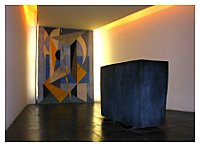| "We all have within us a center of stillness surrounded by silence.
This house, dedicated to work and debate in the service of peace,
should have one room dedicated to silence in the outward sense and stillness
in the inner sense.
It has been the aim to create in this small room a place where the
doors may be open to the infinite lands of thought and prayer.
People of many faiths will meet here, and for that reason none of
the symbols to which we are accustomed in our meditation could be used.
However, there are simple things which speak to us all with the same
language. We have sought for such things and we believe that we have found
them in the shaft of light striking the shimmering surface of solid rock.
So, in the middle of the room we see a symbol of how, daily, the
light of the skies gives life to the earth on which we stand, a symbol
to many of us of how the light of the spirit gives life to matter.
But the stone in the middle of the room has more to tell us. We may
see it as an altar, empty not because there is no God, not because it is
an altar to an unknown god, but because it is dedicated to the God whom
man worships under many names and in many forms.
The stone in the middle of the room reminds us also of the firm and
permanent in a world of movement and change. The block of iron ore has
the weight and solidity of the everlasting. It is a reminder of that cornerstone
of endurance and faith on which all human endeavour must be based.
The material of the stone leads our thoughts to the necessity for
choice between destruction and construction, between war and peace. Of
iron man has forged his swords, of iron he has also made his ploughshares.
Of iron he has constructed tanks, but of iron he has likewise built homes
for man. The block of iron ore is part of the wealth we have inherited
on this earth of ours. How are we to use it?
The shaft of light strikes the stone in a room of utter simplicity.
There are no other symbols, there is nothing to distract our attention
or to break in on the stillness within ourselves. When our eyes travel
from these symbols to the front wall, they meet a simple pattern opening
up the room to the harmony, freedom and balance of space.
There is an ancient saying that the sense of a vessel is not in its
shell but in the void. So it is with this room. It is for those who come
here to fill the void with what they find in their center of stillness."
|


